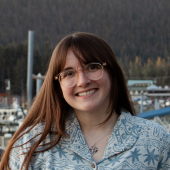
The Alaskan Seaweed Genetics Workshop (April 2024) - Searching for seaweed solutions; summary and conclusions
Jessica Whitney, Research Professional, University of Alaska Fairbanks, USA

The Alaskan Seaweed Genetics Workshop (April 2024) - Searching for seaweed solutions; summary and conclusions
Jessica Whitney, Research Professional, University of Alaska Fairbanks, USA
About speaker:
Jessica graduated with a B.S. in Marine Biology and a Certificate of Outdoor Skills & Leadership from the University of Alaska Southeast in 2023 and is a Research Professional with the University of Alaska Fairbanks, Alaska Sea Grant, and the NOAA Alaska Fisheries Science Center. Jessica grew up in Southern California and was often found investigating the tidepools of Santa Barbara. After sailing across the Western North Atlantic and performing oceanographic research, she fell in love with experiential learning and desired an education that went beyond four walls and a textbook. She found herself in Juneau, Alaska in the Fall of 2018. As an undergrad, she worked as a research technician on a large field ecology investigation of how the marine ecosystem is responding to reintroduction of sea otters in Southeast Alaska. It was here where she found an admiration for seaweeds and the important role they play in the nearshore. Jessica can be described as “having a finger in many pies,” but prefers the saying to be “having hands in many tidepools.”
Company:
The University of Alaska Fairbanks is a Land, Sea, and Space Grant university and an international center for research, education, and the arts, emphasizing the circumpolar North and its diverse peoples. UAF integrates teaching, research, and public service as it educates students for active citizenship and prepares them for lifelong learning and careers.
Presentation:
Preservation of genetic diversity remains an important topic in conservation genetics and aquaculture. Resource managers in Alaska are concerned about the genetic impacts of aquaculture on wild stocks, and as a result have adopted a precautionary approach. This precautionary regulation mandates that a minimum of 50 wild individuals within a 50 km radius be used as a seed source for seaweed farming. This regulation has the potential to limit the growth of the industry, and so the industry is interested in identifying alternative approaches. The genetic structure of seaweed species can vary from region to region and overall, remains lesser known, despite the commercial and ecological importance of these species. In April, Alaska Sea Grant, the Alaska Mariculture Research and Training Center, and the Alaska Fisheries Development Foundation hosted a Seaweed Genetics Workshop with goals to illuminate areas of research to support the sustainable management of seaweed aquaculture as well as initiate a conversation between scientists and industry. Scientists from within and outside of Alaska gathered to learn how various regions address seaweed genetics concerns with hopes to inform management of practices that can support industry growth without harming wild stocks. Topics of discussion included population genetics of kelp along the east coast and Puget Sound, selective breeding of macroalgae in New England, gametophyte cultivation, non-reproductive kelp, seed banking, as well as heat stress tolerance of seaweeds in a changing ocean. Panel and breakout discussions focused on exploring how this information could be applied in Alaska. Our presentation will describe future directions of research to inform future management and continued growth of Alaska’s mariculture industry that were recommended in the workshop.